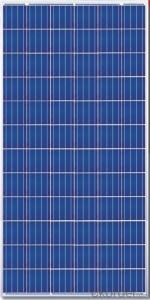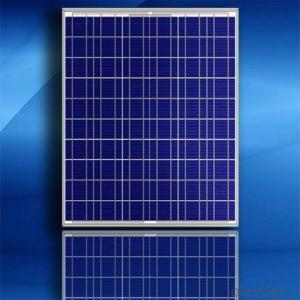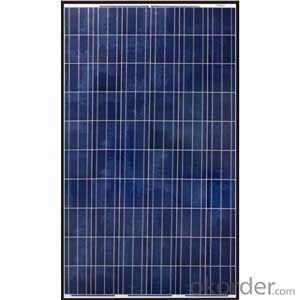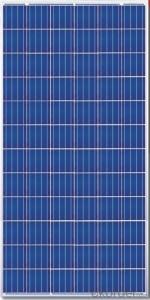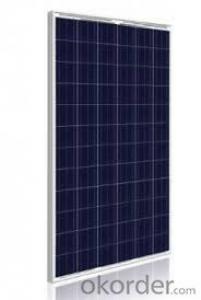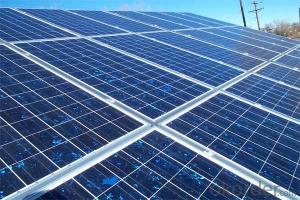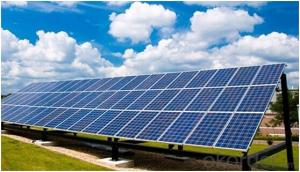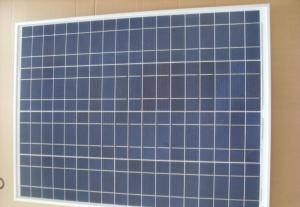240w Lg Pv Poly Solar Panel Medium Solar Panel Factory Direct Sale Cnbm
- Loading Port:
- Qingdao
- Payment Terms:
- TT OR LC
- Min Order Qty:
- 10 set
- Supply Capability:
- 300000 set/month
OKorder Service Pledge
OKorder Financial Service
You Might Also Like
Polycrystalline Solar Modules
CNBM offers a range of small, medium and large polycrystalline solar modules, designed for a range of requirements.
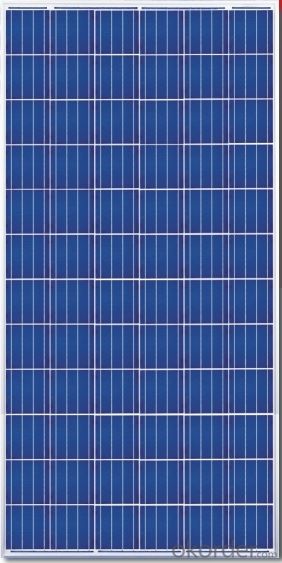
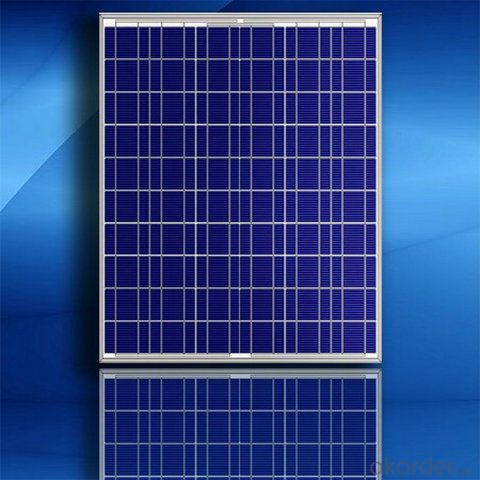
Specifications:
Tolerance | +/-3% |
Cel | Polycrystalline silicon solar cells (156 x 156mm) |
N0. of Cells | 60 (10 x 6) |
Dimension of Modules (mm) | 1650 x 990 x 40 |
Weight (kg) | 25.5 |
Limits:
Operating Temperature | -40~+85? |
Storage Temperature | -40~+85? |
Maximum System Voltage | 1000 VDC max. |
Hail Impact | Diameter of 28mm with impact speed |
Temperature and Coefficients:
NOCT | 48C+/-2? |
Voltage temperature coefficient (%/K) | -0.35 |
Current temperature coefficient (%/K) | 0.05 |
Power temperature coefficient (%/K) | -0.45 |
Characteristics:
Model: | SGM-200P | SGM-210P | SGM-220P |
Max-power voltage Vmp (V) | 29.2 | 29.4 | 29.41 |
Max-power current Imp (A) | 6.85 | 7.14 | 7.48 |
Open-circuit voltage Voc (V) | 36.5 | 36.69 | 36.9 |
Short-Circuit Current Isc (A) | 7.28 | 7.6 | 7.93 |
Max-power Pm(W) | 200 | 210 | 220 |
Model: | SGM-230P |
Max-power voltage Vmp (V) | 29.8 |
Max-power current Imp (A) | 7.72 |
Open-circuit voltage Voc (V) | 37.31 |
Short-Circuit Current Isc (A) | 8.19 |
Max-power Pm(W) | 230 |
STC: Irradiance 1000W/m2, module temperature 25?, AM-=1.5
Poly Crystalline Solar Panels Specifications Range
Maximum Power (Pm) | Dimension | Weight | Operating Voltage (Vmp) | Operating Current (Imp) | Open Circuit Voltage (Voc) | Short Circuit Current (Isc) |
0.45W | 140x80x10mm | 0.08kg | 3.3V | 150mA | 4.6V | 160mA |
1.0W | 162x140x10mm | 0.16kg | 7.5V | 150mA | 10.3V | 160mA |
4.5W | 269x251x23mm | 0.8kg | 16.5V | 0.27A | 20.5V | 0.3A |
10W | 420.1×268.9×22.6mm | 1.92kg | 17.5V | 0.58A | 20.5V | 0.6A |
20W | 425x502x50mm | 3.0kg | 16.8V | 1.19A | 21.0V | 1.29A |
30W | 593x502x22.6mm | 3.9kg | 16.8V | 1.78A | 21.0V | 1.94A |
40W | 655x537x50mm | 5.75kg | 17.3V | 2.31A | 22.1V | 2.54A |
50W | 839x537x50mm | 6.0kg | 17.5V | 2.9A | 21.8V | 3.17A |
65W | 1111x502x50mm | 7.2kg | 17.6V | 3.69A | 22.1V | 3.99A |
80W | 1204x537x50mm | 7.7kg | 17.6V | 4.55A | 22.1V | 4.8A |
- Q: How do solar panels affect the property's energy consumption?
- Solar panels can significantly reduce a property's energy consumption by generating electricity from sunlight, thereby offsetting the need to draw power from the grid. This helps to lower utility bills and decrease reliance on fossil fuels, leading to both financial and environmental benefits.
- Q: My mom's house has some solar power panels on the top of her house but they are not connected to anything. They don't even have wires or anything like that. Does anyone know how to connect and make solar panels work? Thank You
- It sounds like you nor anyone at your home knows enough about solar to be able to hook them up no matter what type they are. I have to agree with others that they could be hooked up and you just can't see the connections. So the best thing for you to do is get a contractor to come out and check them out. It don't have to be a Solar Dealer because I am a dealer and I use electrical contractors to do the installs. A solar dealer is not always legal to install and normally do like I do and just design and sell the systems. However most any dealer can easly install a solar power system because they are trained just not legal to do the work. Having someone other then an electrician work on it could void the warranties.
- Q: How do solar panels affect the overall comfort of a building?
- Solar panels can positively impact the overall comfort of a building by reducing energy costs and improving indoor temperature control. They generate clean and renewable electricity, which can power various systems such as heating, ventilation, and air conditioning (HVAC) units. This helps to regulate the indoor temperature more efficiently, leading to a more comfortable environment for occupants. Moreover, solar panels can also reduce reliance on the grid, ensuring a more reliable energy supply and enhancing the comfort and stability of the building.
- Q: I want to know how to hook up a Solartech SPM020P-R, 20W Solar Panel to a single outlet that you can but at a store.
- That solar panel puts out about amp (in round numbers). If you are talking about a 20vac outlet, you'll have to send the output of the solar panel through an inverter. That brings it up to 20vac. 20 watts at 20 volts means you'll only be able to draw 0.6667 amps. With an inverter at 85% efficiency, you'll only get about 0.4 amps. That would barely light a CFL. 20 watts of power at 7 volts = amp (in round numbers) 20 watts of power at 20vac = 0.6667 amp (in round numbers) Power (watts) = current x voltage. If you increase voltate, you must decrease current to get the same watts. Watts is the common denominator in power measurement.
- Q: Can solar panels be installed on a recreational vehicle (RV)?
- Yes, solar panels can be installed on a recreational vehicle (RV). This is a popular option for RV owners who want to generate their own electricity and reduce their reliance on traditional power sources while on the road. Solar panels can be mounted on the roof of an RV and connected to the onboard battery system to provide power for various appliances and devices.
- Q: I have four power packs for solar lights. They have 3 AA .2volt batteries of 2450 mAh capacity installed in series for a total supply voltage of 4 volt maximum for the lights. I want to charge all four packs at once off a single 6 volt solar panel. With the four packs wired in parallel, what capacity output (wattage) panel do I need to charge the batteries in an 8 hour day?
- WIRE THEM IN PARALLEL BUT MUST VIA ONE BLOCKING DIOED FOR EACH 4V BATTERY BANK ( LIGHT) BETWEEN SOLAR PANEL OUTPUT TO EACH BATTERY BANK. DIODE USES LIKE N5404 THAT CAN HANDLE 3A OR HIGHER IS BETTER. TOTAL AH = 9.8 AH FROM ALL 4 LIGHTS. NOT 25AH FROM YOUR MISTAKE RATE. TO CHARGE THEM FULLY IN 8 HOURS, CHARGING CURRENT AT LEAST .3A BUY SOLAR PANEL HAS OUTPUT 6V 2A ( OR 0W ) IS GOOD ENOUGH.
- Q: I would love to put in solar panels on my roof, but how hard would it be, and how expensive? Would I be able to do the work myself, or would I have to hire a pro?Also I live in Oregon, so much of the time it is overcast, so would it really be worth it?
- Not a good idea. The reason why panels are that much more expensive than cells is that the panels themselves are not that cheap either. If you start with the cells, you'll need - mechanical protection (hail, ice, snow) - electrical protection (i.e. waterproofing - if water comes in contact with the cells and wires, you'll get electrolysis which will corrode your wires and contacts faster than you can say 'b*mmer') - that setup will need to withstand temperatures between -20 and +30 °C (only guessing, might be worse) - oh, and the side facing the sun must be transparent (as far as possible) Now as to connecting the stuff: no, it will be neither easy to connect it to the house power nor to the grid - which is why that step (at least) in all countries I know of must be done by a certified electrician. If you get it wrong and you're lucky, only _your_ inverter will explode. Regarding the power: these 4W per cell (or kW for your shed) is the peak value, i.e. with the sun shining orthogonally onto the cells on a clear day. Since this (for a fixed installation) will only be true (at most) for a few minutes on a few days each year, your overall yield will be significantly less, probably more like 4 kWh/day for each clear day for each kWpeak you install _IF_ the shed roof is oriented exactly south and inclined towards the sun's noon position at the spring/autumn equinox (i.e. inclination angle = your geographical latitude). How many clear days do you have in britain? Yes, I had a similar idea for myself - but for one thing, the registered companies I addressed apparently weren't really interested in that small fry, plus the cost of the system + setup would barely have been amortized after the expected lifetime, even taking into account the (german) governmental subsidies. If I had the money to spare, I'd rather invest in a communal solar park. Much better ROI, the large installations get much better prices (per kW) for the setup.
- Q: OK, so if you put solar panels up on a roof, they are busy turning the sun's energy into electricity. So, does that mean the roof (and therefore the house/structure) stays cooler as well? Or does it still get hot, because . . . I dunno, maybe the panels don't convert all the energy, and the spillover still heats up the building.Any links or URLs to scientific answers would be appreciated, but I don't mind hearing from the Average Joe or (Joelle).
- I asked the same question once to a PV install during a seminar a few years back, and he explained the following: No, PV panels do not reflect or absorb much heat from going into the building below but there is a reason for this: PV panels that reflect / absorb heat produce less electricity. They are designed to Thermally Transparent. Even worse if installed incorrectly without a good angle and air gap to allow the heat to escape the panels will actually trap this heat and increase the interior temperature of the building below! Below is the scientific analysis that is quite verbose but has two nice graphs at the end. To summarize: Adding PV panels, at best, shaded the building enough to reduce the load of the interior A/C unit by .8 kWh/sq-m/year. The electricity generated by the panels was about 356 kWh/sq-m/year. You can see the big advantage of PV panels is to make power, not reflect heat. Proper insulation is much cheaper and will do a much better job. Don’t worry, I was shocked too, but like anything it makes sense after it is explained.
- Q: Our school is in the process of being built, but they have no plans to include any environmental benefits. I was wondering how to get a grant for solar panels (at least) or who I can talk to in order to get a grant.
- You might do better looking at a more economical environmental project. In most parts of the US, solar panels simply don't pay for themselves over their equipment life. Schools won't be eligible for tax credits (since they don't pay taxes) and so solar panels will likely take more than 40 years to pay for themselves. The life of a solar panel is expected to be 25 years. You should, however, try to talk to the school board about things like solar water heating (which can have a very attractive payback) and light fixtures that have sockets such that they will only take compact flourescent bulbs and skylights to allow for less lighting use in classrooms and perhaps even ground source heat pumps for space heating. All of these can be quite economical, and will make more sense when installed during construction. Good luck.
- Q: Can solar panels be used for heating swimming pools?
- Yes, solar panels can be used for heating swimming pools. Solar thermal panels, also known as solar collectors, are specifically designed to capture and convert sunlight into heat energy, which can be used to warm the water in swimming pools. This method of heating pools is environmentally friendly and cost-effective in the long run, as it relies on free and abundant solar energy.
Send your message to us
240w Lg Pv Poly Solar Panel Medium Solar Panel Factory Direct Sale Cnbm
- Loading Port:
- Qingdao
- Payment Terms:
- TT OR LC
- Min Order Qty:
- 10 set
- Supply Capability:
- 300000 set/month
OKorder Service Pledge
OKorder Financial Service
Similar products
Hot products
Hot Searches
Related keywords
